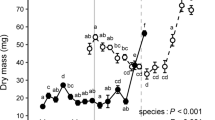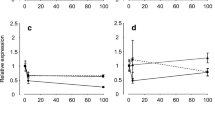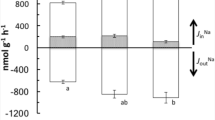Abstract
Teleost fish have a remarkable capacity to maintain ion homeostasis against diffusion gradients in hypo-ionic freshwater. In adult teleosts the gills are the primary site for ion uptake; however, in larvae, the gills are underdeveloped, and as ion-regulation is primarily cutaneous, branchial mechanisms of plasticity are not yet available. In larval rainbow trout, the gills become the primary site for Na+ uptake at ~ 15 days post hatch (dph). To address how Na+ uptake develops in response to differences in water [Na+], the present study characterised the ontogeny of Na+ uptake in rainbow trout larvae, at a time when ion regulation transitions from being a primarily cutaneous to a primarily branchial process. Results indicate that initially (0–15 dph), when ion-regulation is cutaneous, low-[Na+] reared larvae had a higher Na+ affinity (lower Km) compared to the high-[Na+] treatment. In addition, larvae reared in low-[Na+] water had a lower internal Na+ content, despite similar Na+-uptake rates (\({J}_{{\mathrm{Na}}^{+}}^{\mathrm{in}}\)) across treatments. But, once the gills became the dominant site for ion-regulation (> 15 dph), larvae in all treatments maintained the same Na+ content, despite large differences in \({J}_{{\mathrm{Na}}^{+}}^{\mathrm{in}}\), indicating plasticity in those mechanisms that control Na+ efflux (\({J}_{{\mathrm{Na}}^{+}}^{\mathrm{out}}\)). The mechanisms of Na+ uptake in larval rainbow trout showed plasticity during all stages of development. However, in young larvae that relied on cutaneous Na+ uptake, the internal Na+ content was significantly affected by the [Na+] in the water, perhaps revealing challenges to ion homeostasis and a period of heightened vulnerability to external stressors during early larval development.






Similar content being viewed by others
References
Barnawi EA, Doherty JE, Ferreira PG, Wilson JM (2020) Extra-gastric expression of the proton pump H+/K+ -ATPase in the gills and kidney of the teleost Oreochromis niloticus. J Exp Biol. https://doi.org/10.1242/jeb.214890
Boisen A, Amstrup J, Novak I, Grosell M (2003) Sodium and chloride transport in soft water and hard water acclimated zebrafish (Danio rerio). Biochim Biophys Acta Biomembr 1618(2):207–218
Brauner CJ, Rombough PJ (2012) Ontogeny and paleophysiology of the gill: new insights from larval and air-breathing fish. Respir Physiol Neurobiol 184(3):293–300
Brauner CJ, Wood CM (2002) Effect of long-term silver exposure on survival and ionoregulatory development in rainbow trout (Oncorhynchus mykiss) embryos and larvae, in the presence and absence of added dissolved organic matter. Comp Biochem Physiol C Toxicol Pharmacol 133(1–2):161–173
Brix KV, Grosell M (2012) Comparative characterization of Na+ transport in Cyprinodon variegatus variegatus and Cyprinodon variegatus hubbsi: a model species complex for studying teleost invasion of freshwater. J Exp Biol 215(7):1199–1209. https://doi.org/10.1242/jeb.067496
Dymowska AK, Hwang P-P, Goss GG (2012) Structure and function of ionocytes in the freshwater fish gill. Respir Physiol Neurobiol 184(3):282–292
Evans DH, Piermarini PM, Choe KP (2005) The multifunctional fish gill: dominant site of gas exchange, osmoregulation, acid–base regulation, and excretion of nitrogenous waste. Physiolog Rev 85:97–177
Fu C, Wilson JM, Rombough PJ, Brauner CJ (2010) Ions first: Na+ uptake shifts from the skin to the gills before O2 uptake in developing rainbow trout, Oncorhynchus mykiss. Proc R Soc Lond Ser B Biol Sci 277(1687):1553–1560. https://doi.org/10.1098/rspb.2009.1545
Gallagher ZS, Bystriansky JS, Farrell AP, Brauner CJ (2013) A novel pattern of smoltification in the most anadromous salmonid: pink salmon (Oncorhynchus gorbuscha). Can J Fish Aquat Sci 70(3):349–357. https://doi.org/10.1139/cjfas-2012-0390
Glazier DS (2005) Beyond the ‘3/4-power law’: variation in the intra- and interspecific scaling of metabolic rate in animals. Biol Rev 80(4):611–662
Gonzalez R, Mcdonald D (1994) The relationship between oxygen uptake and ion loss in fish from diverse habitats. J Exp Biol 190(1):95–108
Gonzalez RJ, McDonald DG (1992) The relationship between oxygen consumption and ion loss in a freshwater fish. J Exp Biol 163(1):317–332
Goss GG, Wood CM (1990) Na+ and Cl- uptake kinetics, diffusive effluxes and acidic equivalent fluxes across the gills of rainbow trout: I. Responses to environmental hyperoxia. J Exp Biol 152(1):521–547
Greco A, Fenwick J, Perry S (1996) The effects of soft-water acclimation on gill structure in the rainbow trout Oncorhynchus mykiss. Cell Tissue Res 285(1):75–82
Hughes GM (1984) General anatomy of the gills. In: Hoar WS, Randall DJ (eds) Fish physiology, vol XA. Academic Press, New York, pp 1–63
Hwang P-P (1990) Salinity effects on development of chloride cells in the larvae of ayu (Plecoglossus altivelis). Mar Biol 107(1):1–7
Hwang P-P, Lee T-H, Lin L-Y (2011) Ion regulation in fish gills: recent progress in the cellular and molecular mechanisms. Am J Physiol Regul Integr Comp Physiol 301(1):R28–R47
Hwang P-P, Lee TH (2007) New insights into fish ion regulation and mitochondrion-rich cells. Comp Biochem Physiol A Mol Integr Physiol 148(3):479–497. https://doi.org/10.1016/j.cbpa.2007.06.416
Inokuchi M, Hiroi J, Watanabe S, Hwang P-P, Kaneko T (2009) Morphological and functional classification of ion-absorbing mitochondria-rich cells in the gills of Mozambique tilapia. J Exp Biol 212(7):1003–1010
Katoh F, Shimizu A, Uchida K, Kaneko T (2000) Shift of chloride cell distribution during early life stages in seawater-adapted killifish, Fundulus heteroclitus. Zool Sci 17(1):11–19
Killen SS, Costa I, Brown JA, Gamperl AK (2006) Little left in the tank: metabolic scaling in marine teleosts and its implications for aerobic scope. Proc R Soc Lond Ser B: Biol Sci 274(1608):431–438
Krogh A (1941) The comparative physiology of respiratory mechanisms. University of Pennsylvania Press, Philadelphia
Lauren DJ, McDonald DG (1987) Acclimation to copper by rainbow trout, Salmo gairdneri: Physiology. Can J Fish Aquat Sci 44:99–104
Laurent P, Hõbe H, Dunel-Erb S (1985) The role of environmental sodium chloride relative to calcium in gill morphology of freshwater salmonid fish. Cell Tissue Res 240(3):675–692
Marshall WS, Grosell M (2006) Ion transport, osmoregulation and acid–base balance. In: Evans D, Claiborne JB (eds) The physiology of fishes, 3rd edn. CRC Press, Boca Raton, pp 177–230
Matsuo AY, Playle RC, Val AL, Wood CM (2004) Physiological action of dissolved organic matter in rainbow trout in the presence and absence of copper: sodium uptake kinetics and unidirectional flux rates in hard and softwater. Aquat Toxicol 70(1):63–81
McDonald D, Rogano M (1986) Ion regulation by the rainbow trout, Salmo gairdneri, in ion-poor water. Physiol Zool 59(3):318–331
McWilliams PG, Shephard KL (1989) Kinetic characteristics of the sodium uptake mechanism during the development of embryos and fry of Atlantic salmon, Salmo salar L., in an improved water quality. J Fish Biol 35:855–868
Miles HM, Smith LS (1968) Ionic regulation in migrating juvenile coho salmon, Oncorhynchus kisutch. Comp Biochem Physiol 26(2):381–398
Morgan JD, Iwama GK (1991) Effects of salinity on growth, metabolism, and ion regulation in juvenile rainbow and steelhead trout (Oncorhynchus mykiss) and fall chinook salmon (Onchorhynchus tshawytscha). Can J Fish Aquat Sci 48(11):2083–2094
Perry SF, Rivero-Lopez L, McNeill B, Wilson J (2006) Fooling a freshwater fish: how dietary salt transforms the rainbow trout gill into a seawater gill phenotype. J Exp Biol 209:4591–4596
Potts W, Foster M, Rudy P, Howells GP (1967) Sodium and water balance in the cichlid teleost, Tilapia mossambica. J Exp Biol 47(3):461–470
Rombough P (2002) Gills are needed for ionoregulation before they are needed for O2 uptake in developing zebrafish. Danio rerio J Exp Biol 205(12):1787–1794
Rombough P (2007) The functional ontogeny of the teleost gill: which comes first, gas or ion exchange? Comp Biochem Physiol A Mol Integr Physiol 148(4):732–742
Rombough PJ (1999) The gill of larvae. Is it primarily a respiratory or an ionoregulatory structure? J Fish Biol 55:186–204
Rombough PJ, Moroz BM (1990) The scaling and potential importance of cutaneous and branchial surfaces in respiratory exchange in young chinook salmon (Oncorhynchus tshawytscha). J Exp Biol 154:1–12
R StudioTeam (2016) RStudio: Integrated Development Environment for R. 1.1.383 edn. RStudio, Inc., Boston
Sardella BA, Brauner CJ (2007) The osmo-respiratory compromise in fish. In: Fernandes MN, Rantin FT, Glass ML, Kapoor BG (eds) Fish respiration and environment. Science Publishers, Enfield, pp 147–165. https://doi.org/10.1201/b11000-9
Shen A, Leatherland J (1978) Effect of ambient salinity on ionic and osmotic regulation of eggs, larvae, and alevins of rainbow trout (Salmo gairdneri). Can J Zool 56(4):571–577
Varsamos S, Nebel C, Charmantier G (2005) Ontogeny of osmoregulation in postembryonic fish: a review. Comp Biochem Physiol A: Mol Integr Physiol 141(4):401–429
Weisbart M (1968) Osmotic and ionic regulation in embryos, alevins, and fry of the five species of Pacific Salmon. Can J Zool 46:385–397
Wells PR, Pinder AW (1996a) The respiratory development of Atlantic salmon I. Morphometry of gills, yolk sac and body surface. J Exp Biol 199:2725–2736
Wells PR, Pinder AW (1996b) The respiratory development of Atlantic salmon II. Partitioning of oxygen uptake among gills, yolk sac and body surfaces. J Exp Biol 199:2737–2744
Wood CM (1991) Branchial ion and acid-base transfer in freshwater teleost fish: environmental hyperoxia as a probe. Physiol Zool 64(1):68–102
Wood CM, Bucking C (2010) The role of feeding in salt and water balance. In: Grosell M, Farrell AP, Brauner CJ (eds) Fish physiology: the multifunctional gut of fish vol 30. Academic Press, London, pp 165–212
Yan J-J, Chou M-Y, Kaneko T, Hwang P-P (2007) Gene expression of Na+/H+ exchanger in zebrafish H+-ATPase-rich cells during acclimation to low-Na+ and acidic environments. Am J Physiol Cell Physiol 293(6):C1814–C1823
Zar JH (2009) Biostatistical analysis. Prentice Hall, Upper Saddle River
Zimmer AM, Wright PA, Wood CM (2014) What is the primary function of the early teleost gill? Evidence for Na+/NH4+ exchange in developing rainbow trout (Oncorhynchus mykiss). Proc R Soc Lond Ser B Biol Sci 281(1795):20141422
Zimmer AM, Wright PA, Wood CM (2017) Ammonia and urea handling by early life stages of fishes. J Exp Biol 220(21):3843–3855
Acknowledgements
Dedicated to the memory of Emily Gallagher who sadly passed away on June 22nd, 2015, at the young age of 27. Emily conducted all experiments, analyzed and interpreted the data and wrote a first version of the manuscript as her MSc. thesis. Thanks are due to Patricia Ferreira for validating the antibodies, Sara Northrup and the Fraser Valley Trout Hatchery for providing the rainbow trout embryos, Patrick Tamkee and Victor Chan for their assistance with fish care and Kevin Brix for valuable feedback on this manuscript. This study was supported by a Natural Sciences and Engineering Research Council of Canada (NSERC) Discovery Grant (261924-13) and an Accelerator Supplement (446005-13) to CJB.
Author information
Authors and Affiliations
Corresponding author
Additional information
Communicated by Bernd Pelster.
Publisher's Note
Springer Nature remains neutral with regard to jurisdictional claims in published maps and institutional affiliations.
Electronic supplementary material
Below is the link to the electronic supplementary material.
Rights and permissions
About this article
Cite this article
Gallagher, E.J., Harter, T.S., Wilson, J.M. et al. The ontogeny of Na+ uptake in larval rainbow trout reared in waters of different Na+ content. J Comp Physiol B 191, 29–42 (2021). https://doi.org/10.1007/s00360-020-01311-3
Received:
Revised:
Accepted:
Published:
Issue Date:
DOI: https://doi.org/10.1007/s00360-020-01311-3




